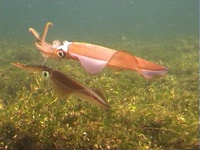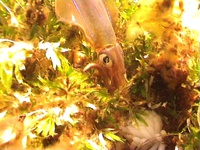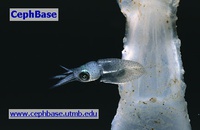Squid mating: Calamari nuptials
The Redmap Team.
Squid display different colours and patterns when they are courting, mating, and laying eggs. This has been coined the squid ‘nuptial dance’...
Squid display many different colours and postural patterns when they are courting, mating, and laying eggs. Squid communicate via changes in body colour patterns and posture. The surface of a squid’s skin is covered with pigment filled sacs called ‘chromatophores’ and each sac has independent neural control so that the squid can expand or shrink each chromatophore. By expanding or shrinking all the chromatophores over the body surface, they can produce many different patterns (see this article for more info). The squid ‘nuptial dance’ as it has been coined, has been studied in detail in southern calamari by Dr Troy Jantzen, and he has been kind enough to allow reproduction of some of his amazing photos. Calamari form spawning pairs, with each male actively protecting his female partner and fending off any unwanted ‘single’ males that try to mate with her. The pairs will mate together several times during a spawning bout, although females may also store sperm, and then lay the eggs on their own. Spawning pairs may aggregate and spawn together in large schools, with several pairs laying eggs on the one egg mop. The eggs appear to be most commonly attached to Amphibolis sea grass, with individual egg capsules containing 4-7 eggs, with 50 to several hundred capsules joined together to form an egg mop. Development of the eggs takes about 3-5 weeks depending on the water temperature, with faster development in warmer water. Newly hatched calamari are 4-7mm in body length and are hatched as miniature, fully competent,mini-adults.
Reproductive behaviour in southern calamari is elaborate and involves complex courtship postures and colour changes, but mating itself only takes 2 seconds if that! The male has a modified tip at the base of one arm that he uses to grab a packet of sperm to pass to the female. Dr Jantzen has named one of the male colour displays associated with this ‘the postman’, as he said that when he sees that pattern, he knows a package has been successfully delivered.
Some of the most fascinating aspects of calamari reproductive behaviour highlight the unique way that a squid communicate with each other, and demonstrates that they can have two conversations at once (even the male squid)! A common example of this involves the intense male competition for females on the spawning grounds. If an amorous male is swimming alongside a willing female he use color changes to say one thing to her with one side of his body (“Hey baby, how about it?”), and send a different message at the same time with the other side of his body to any single males hanging around (“Back off buddy, this babe’s mine!”). Female squid can respond with several signals from “I wouldn't mate with you if you were last squid on earth...” to “sure honey”.
Sometimes the competition between males escalates into physical fighting, with paired males charging at intruders and literally beating them with their fins. To avoid such aggression, some single males resort to rather dastardly tactics to secure a mate. These males, aptly called ‘sneaker males’ sometimes show the body patterns of females, so that the paired male thinks the intruder is a female and therefore nothing to worry about. However, such tactics have their downside as ‘sneaker males’ often attract unwanted attention from other single males- yep, that would be the sneaker males often get mated by the larger paired males.
Based on an article written by Dr Gretta Pecl, Institute for Marine and Antarctic Studies, for Tasmanian Fishing & Boating News (2005)
Reference: Jantzen, TM & Havenhand, JN. (2003). Reproductive behaviour in the squid Sepioteuthis australia from South Australia: interactions on the spawning grounds. Biol. Bulletin, 204: 305-17.















